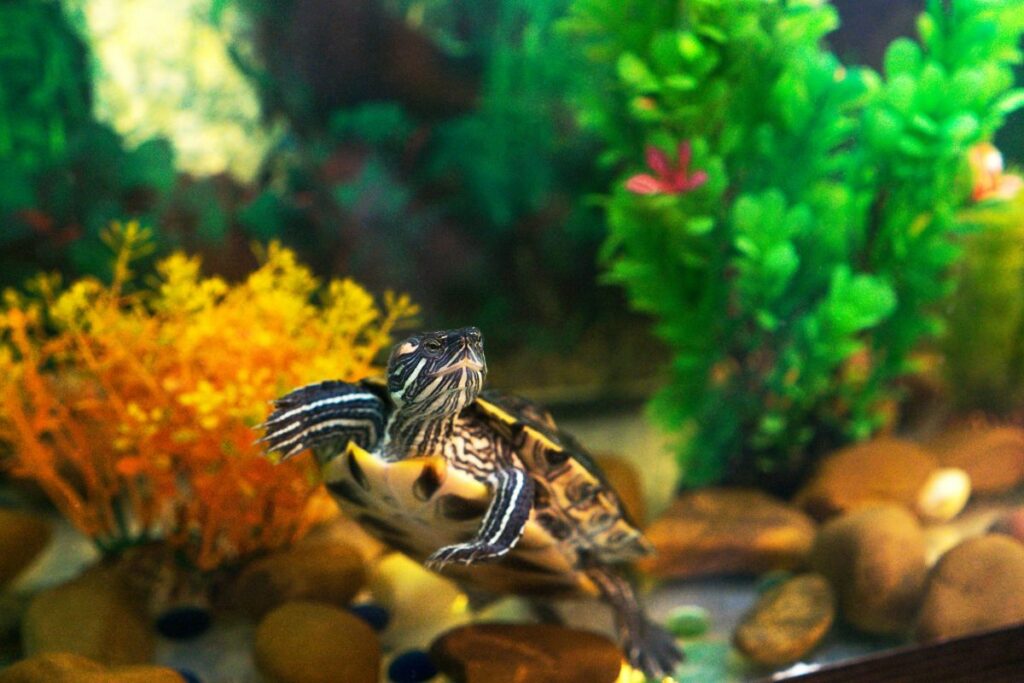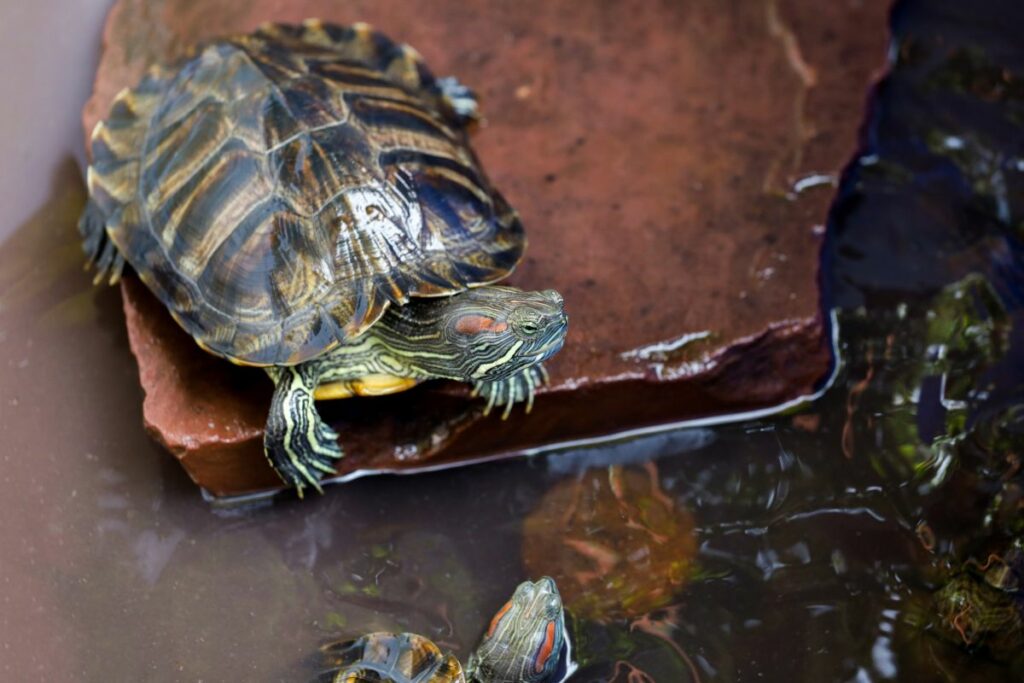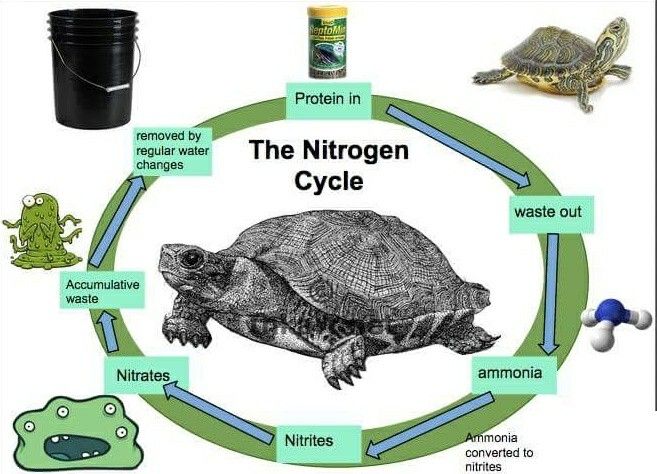Preparing a tank for your new turtle can be daunting if you’ve never done it before; there’s so much you need to know to keep your turtle safe. Who knew that water could be dangerous to an aquatic turtle if you didn’t prepare it properly beforehand?

Before buying your turtle, you’ll need to cycle your tank, allowing your aquarium to build beneficial bacteria to break down toxins in the water.
Learning how to cycle your turtle’s tank takes some time, but it doesn’t have to be complicated.
Cycling Your Turtle Tank
Cycling the water in your aquarium is essential before you add your new turtle to its tank. Cycling generally takes about four to eight weeks, so plan to set up your tank well before purchasing your turtle.
“Cycling” refers to the nitrogen cycle, a process all aquariums containing water must go through before they’re healthy for living animals.
What Is The Nitrogen Cycle?
Nitrogen is the most abundant element in the atmosphere and is essential to all life on earth. Nitrogen is everywhere, including plants, soil, water, and air.
Nitrogen is the key to life, and too little nitrogen cannot sustain life, but too much nitrogen can be toxic. There needs to be a perfect balance of nitrogen for everything to live, including your turtle, which is why the nitrogen cycle is so important.
Observing wild water habitats, we can see the problem with too much nitrogen. Too much nitrogen in water leads to “eutrophication,” which causes excess algae growth — this happens in our aquariums, too.
Sometimes, eutrophication is so harmful that phytoplankton blooms occur— phytoplankton is a type of algae. Blooms turn the water green and absorb all the nutrients in the water.
Once phytoplankton consumes all the nutrients, they die, and the microbes in the water consume the phytoplankton, depleting the levels of oxygen in the water. Water that doesn’t contain enough dissolved oxygen becomes a “dead zone” that can no longer support life.
In aquariums, too much nitrogen creates a similar environment, creating toxic water that can kill your fish.
For your aquarium to be safe for your fish, it must first undergo the “nitrogen cycle,” in which beneficial bacteria become present to neutralize dangerous toxins.
Frontiers describes the nitrogen cycle:
“The nitrogen cycle is a repeating cycle of processes during which nitrogen moves through both living and non-living things: the atmosphere, soil, water, plants, animals and bacteriaMicroscopic living organisms that usually contain only one cell and are found everywhere. Bacteria can cause decomposition or breaking down, of organic material in soils… In order to move through the different parts of the cycle, nitrogen must change forms.”
The nitrogen cycle is complex regarding the earth: air, soil, and water. To make things less complicated, we’re only going to discuss the nitrogen cycle as it relates to our aquariums.
Ammonia Builds In Your Tank
As you begin your new tank, ammonia builds in the water, which is toxic to your turtle and is also why you should not add your turtle to the tank until cycling is over.
As ammonia builds up, your tank also begins to develop beneficial bacteria, called Nitrosonomas marina, that accumulate in the gravel, rocks, wood, and filter. Beneficial bacteria are the key elements in the nitrogen cycle because they break down toxins.
You Can Speed Up The Process
To speed up the cycling process, you can add a bit of fish or turtle food to the water to jump-start the ammonia spike. You can also buy bacteria from the pet store to add to your water to speed up the breakdown of ammonia.
A cheaper way to add established bacteria to your tank is to add bacteria from another aquarium in your home or a friend’s tank. The easiest way is by adding filter media from an established tank to your own. Bacteria love to grow within filter media, so this is the most efficient way of adding bacteria to your tank.
Ammonia Dissipates & Nitrites Spike
As beneficial bacteria develop, they break the ammonia into nitrites, another toxic substance. Over time, new bacteria, Nitrobacter and Nitrospira, grow in the aquarium to break the nitrites down into nitrates.
The End Of The Cycle — Nitrates
Nitrates are less toxic and will only harm your turtle in large amounts (>40 ppm).
Why Are Filters So Important For Keeping Your Tank Safe?
Filters are essential pieces of equipment that help with the continuation of the nitrogen cycle. The RSPCA explains why this is:
“Beneficial bacteria grow on any surface in the aquarium and they are concentrated in the filter sponge/media which has a high surface area. By constantly flowing water through the filter, ammonia and nitrite are rapidly converted to nitrates, assisting in keeping tank water free of toxic levels of these compounds.”
When Is It Safe To Add Your Turtle?
You’ll first see a spike in ammonia followed by a drop in ammonia and a spike in nitrites. Then, you’ll see a drop in nitrites and a spike in nitrates. As the cycle completes, the nitrates will drop. At this point, there should be no ammonia or nitrites and only a minimal amount of nitrates, meaning the water is safe for your turtle.
Because ammonia and nitrites are highly toxic, no amount should be in the water. The water is safe once the ammonia and nitrite levels have dropped to 0 ppm and the nitrates have dropped below 40 ppm.
As you cycle your tank, you should test the water daily; I recommend using the API Master Test Kit. By testing the water daily, you can watch as your aquarium goes through the cycling process, and you’ll know when your aquarium is safe.
Introducing Your Turtle to the Tank

To make this process as stress-free as possible, gently lower your turtle into its tank; their shells are very fragile, so don’t drop them. When picking your turtle up, do so by the sides of the shell. NEVER pick your turtle up by its legs, head, or tail.
Don’t worry if your turtle seems stressed at first — this is normal because they aren’t used to the new space.
Continue to test the water parameters every day for about a week to ensure the water hasn’t had a spike in ammonia, nitrites, or nitrates.
What If Your Water Parameters Spike?
Performing regular water changes — every one to two weeks — and cleaning the tank will prevent the water from having ammonia, nitrite, or nitrate spikes.
Continue to test your turtle’s water with each water change, and if you notice spikes in the toxins, you’ll need to perform additional water changes to get the water to a healthy level. You can also add bacteria to the water to neutralize the ammonia.
Conclusion
Your turtle’s tank needs beneficial nitrifying bacteria to be safe. Beneficial bacteria break down toxins like ammonia and nitrite your turtle creates when it produces waste.
It usually takes at least a month for your tank to cycle, so you shouldn’t buy your turtle immediately, but the effort is well worth the wait.
FAQs
You’ll sometimes hear aquarium keepers refer to something called the “fish-in” cycle. A “fish-in” cycle is when you put fish into a brand new tank before the nitrogen cycle has begun. Most people choose cheap, hardy fish like danios and feeder goldfish because they’re more likely to survive the toxic water than other species.
The idea behind a “fish-in” cycle is that the waste the fish produce causes a spike in ammonia faster than would occur in a tank without fish. Adding fish to a brand new tank means your tank may be safe for your turtle in a few weeks instead of over a month.
Many people disagree with doing a “fish-in” cycle because it can be cruel to subject fish to such a toxic and stressful situation. You can do it, though; the fish can be used as food for your turtle afterward.
Filters are essential for your aquatic turtle’s tank because they keep the water cycled and clean. Turtles are dirty, constantly producing waste, and it’s tough to keep up with the level of waste without a filter.

